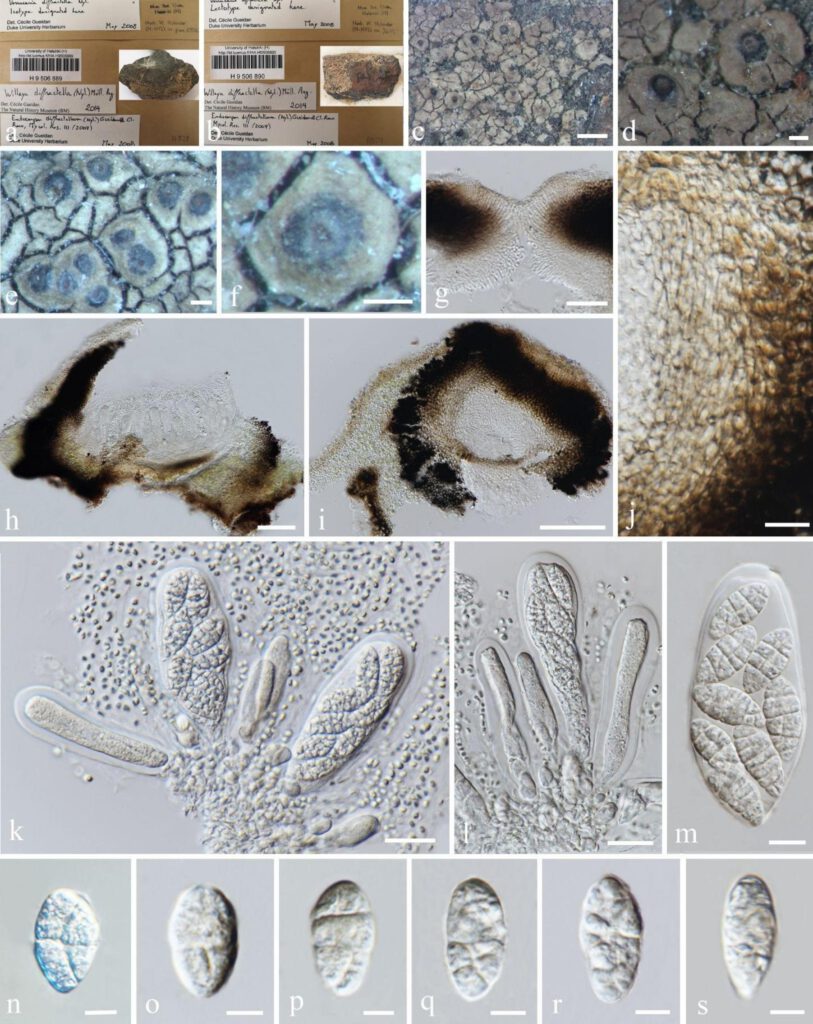Fungalpedia – Note 92 Willeya
Willeya Müll. Arg.
Citation when using the entry: Tian et al., in prep – Fungalpedia, Eurotiomycetes. Mycosphere.
Index Fungorum, Facesoffungi, MycoBank, GenBank, Fig. 1.
The genus Willeya was established by Müller (1883) to accommodate a saxicolous species Willeya diffractella which was segregated from the lichenized genus Staurothele initially because of its ascospores remaining pale at maturity, while species in Staurothele become dark brown. However, Clements (1909) described the genus Phalostauris for Staurothele with pale ascospores, so until 2014, most mycologists considered Willeya as a synonym of Staurothele (Thomson 1991, Brodo et al. 2001). Gueidan et al. (2014) resurrected the genus Willeya with 11 saxicolous species occurring mostly in tropical and subtropical Asia, Australia, and North America based on morphological characters and phylogenetic analysis (Tuckerman 1872, Thomson 1991, Gueidan et al. 2014). Willeya has only a sexual morph with a crustose, thick, cracked, pale brown, epilithic thallus with a pseudocortex, globose, hymenial algae, largely immersed perithecia with a large pale ostiole, and muriform ascospores that remain hyaline to pale brownish at maturity (Gueidan et al. 2014, Aptroot 2016, Orange & Chhetri 2022). Phylogenetically, species in Willeya formed a distinct clade in Verrucariaceae, Verrucariales, Eurotiomycetes based on phylogenies of ITS and LSU sequences (Gueidan et al. 2014). Orange and Chhetri (2022) introduced four species to this genus from Nepal which remains a monophyletic group in Verrucariaceae. Several further Staurothele species may belong in Willeya, but they cannot be reasonably transferred because no type material has been examined and there is no molecular data (Gueidan et al. 2014, Aptroot 2016, Orange & Chhetri 2022). Currently, the genus includes 16 saxicolous species listed by Index Fungorum (2023). Five have been included based on morpho-molecular approaches.
Type species: Willeya diffractella (Nyl.) Müll. Arg.
Other accepted species:
Willeya australis (Groenh.) Gueidan
Willeya eminens Orange
Willeya fusca Gueidan
Willeya honghensis (H. Harada & Li S. Wang) Orange
Willeya irrigata Orange
Willeya iwatsukii (H. Harada) Gueidan
Willeya japonica (B. de Lesd.) Gueidan
Willeya laevigata Gueidan
Willeya malayensis (Zahlbr.) Gueidan
Willeya microlepis (Zahlbr.) Gueidan
Willeya nepalensis Orange
Willeya pallidipora (P.M. McCarthy) Gueidan
Willeya protrudens Gueidan
Willeya rimosa Müll. Arg.
Willeya tetraspora Aptroot
Figure 1 – Willeya diffractella (H, H9506889, isolectotype of Verrucaria diffractella; H, H9506890, lectotype of Verrucaria diffractella). a, b Herbarium specimen. c Habitat of Willeya diffractella. d-f Ascomata immersed in thallus on the host surface. g Vertical section through ostiole. h, i Vertical section of ascomata. j Vertical section through peridium. k-m Asci with hymenial algal cells. n-s Ascospores. Scale bars: c = 1000 µm, d-f = 200 µm, g = 50 µm, h, i = 100 µm, j-l = 20 µm, m = 10 µm, n–s = 5 µm.
References
Aptroot A. 2016 – The first European Willeya (Verrucariaceae) on limestone brought from China. Herzogia 29, 688–691. Doi 10.13158/heia.29.2.2016.688
Brodo IM, Sharnoff SD, Sharnoff S. 2001 – Lichens of North America. New Haven and London, Yale University Press.
Clements FE. 1909 – The Genera of Fungi: 1–227. Doi 10.5962/bhl.title.5704
Gueidan C, Van Do T, Lu NT. 2014 – Phylogeny and taxonomy of Staurothele (Verrucariaceae, lichenized ascomycotes) from the karst of northern Vietnam. Lichenologist 46, 515–533. Doi 10.1017/S0024282914000048
Index Fungorum (2023) Available online: http://www.indexfungorum.org/Names/Names.asp (accessed on 5 June 2023).
Müller J. 1883 – Lichenologische Beiträge XVIII. Flora (Regensburg) 66(22), 344–354.
Orange A, Chhetri S. 2022 – Verrucariaceae from Nepal. The Lichenologist 54(3–4), 139–174. Doi 10.1017/S0024282922000160
Thomson JW. 1991 – The lichen genus Staurothele in North America. Bryologist 94, 351–367. Doi 10.2307/3243824
Tuckerman E. 1872 – Genera Lichenum: An arrangement of the North America lichens, 1–281.
Entry by
Qing Tian & Jiankui Liu, School of Life Science and Technology, Center for Informational Biology, University of Electronic Science and Technology of China, Chengdu 611731, People’s Republic of China
(Edited by Kevin D. Hyde)
Published online 19 September 2023
